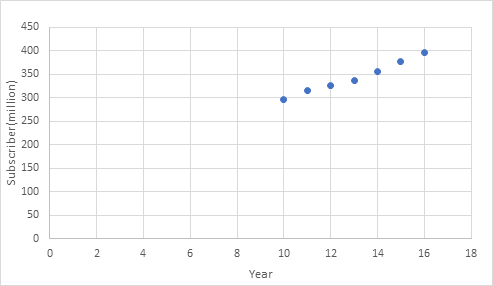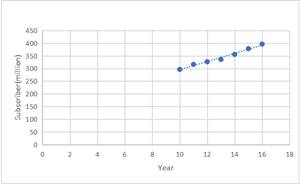
Concept explainers
(a)
To graph: The data given in the table.
(a)
Explanation of Solution
Given data:
Table of year v/s subscriber
Graph:
Graph for the given table:
| Year | Subscribers, S (in millions) |
| 2010 | 296.3 |
| 2011 | 316.0 |
| 2012 | 326.5 |
| 2013 | 335.7 |
| 2014 | 355.4 |
| 2015 | 377.9 |
| 2016 | 395.9 |

Interpretation:
Subscribers are increasing every year.
(b)
To calculate: Linear regression of model.
(b)
Answer to Problem 20E
Linear regression of model is
Explanation of Solution
Given data:
Table of year v/s subscriber
Formula used:
Slope intercept form:
Calculation:
Linear regression of the model:
Conclusion:
Linear regression of model is
(c)
To explain: model is a good fit.
(c)
Answer to Problem 20E
Yes, it is a good fit.
Explanation of Solution
Given data:
Table of year v/s subscriber
Calculation:
Yes, this is a good fit because line of fit is having value nearly to approximately all original values.

Conclusion:
Yes it is a good fit.
(d)
To calculate: Subscriber in 2022.
(d)
Answer to Problem 20E
Subscriber for 2022 will be 495.5millions
Explanation of Solution
Given data:
Table of year v/s subscriber
Calculation:
Subscriber for 2022 will be:
It is a reasonable answer because as the graph is increasing with year.
Conclusion:
Subscriber for 2022 will be 495.5 millions
Chapter 1 Solutions
PRECALCULUS W/LIMITS:GRAPH.APPROACH(HS)
- Find the indefinite integral. (Remember the constant of integration.) √tan(8x) tan(8x) sec²(8x) dxarrow_forwardFind the indefinite integral by making a change of variables. (Remember the constant of integration.) √(x+4) 4)√6-x dxarrow_forwarda -> f(x) = f(x) = [x] show that whether f is continuous function or not(by using theorem) Muslim_mathsarrow_forward
- Use Green's Theorem to evaluate F. dr, where F = (√+4y, 2x + √√) and C consists of the arc of the curve y = 4x - x² from (0,0) to (4,0) and the line segment from (4,0) to (0,0).arrow_forwardEvaluate F. dr where F(x, y, z) = (2yz cos(xyz), 2xzcos(xyz), 2xy cos(xyz)) and C is the line π 1 1 segment starting at the point (8, ' and ending at the point (3, 2 3'6arrow_forwardCan you help me find the result of an integral + a 炉[メをメ +炉なarrow_forward
- I need help making sure that I explain this part accutartly.arrow_forwardPlease help me with this question as I want to know how can I perform the partial fraction decompostion on this alebgric equation to find the time-domain of y(t)arrow_forwardPlease help me with this question as I want to know how can I perform the partial fraction on this alebgric equation to find the time-domain of y(t)arrow_forward
 Calculus: Early TranscendentalsCalculusISBN:9781285741550Author:James StewartPublisher:Cengage Learning
Calculus: Early TranscendentalsCalculusISBN:9781285741550Author:James StewartPublisher:Cengage Learning Thomas' Calculus (14th Edition)CalculusISBN:9780134438986Author:Joel R. Hass, Christopher E. Heil, Maurice D. WeirPublisher:PEARSON
Thomas' Calculus (14th Edition)CalculusISBN:9780134438986Author:Joel R. Hass, Christopher E. Heil, Maurice D. WeirPublisher:PEARSON Calculus: Early Transcendentals (3rd Edition)CalculusISBN:9780134763644Author:William L. Briggs, Lyle Cochran, Bernard Gillett, Eric SchulzPublisher:PEARSON
Calculus: Early Transcendentals (3rd Edition)CalculusISBN:9780134763644Author:William L. Briggs, Lyle Cochran, Bernard Gillett, Eric SchulzPublisher:PEARSON Calculus: Early TranscendentalsCalculusISBN:9781319050740Author:Jon Rogawski, Colin Adams, Robert FranzosaPublisher:W. H. Freeman
Calculus: Early TranscendentalsCalculusISBN:9781319050740Author:Jon Rogawski, Colin Adams, Robert FranzosaPublisher:W. H. Freeman
 Calculus: Early Transcendental FunctionsCalculusISBN:9781337552516Author:Ron Larson, Bruce H. EdwardsPublisher:Cengage Learning
Calculus: Early Transcendental FunctionsCalculusISBN:9781337552516Author:Ron Larson, Bruce H. EdwardsPublisher:Cengage Learning





